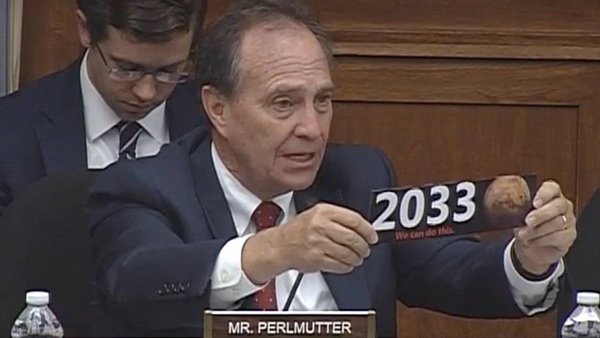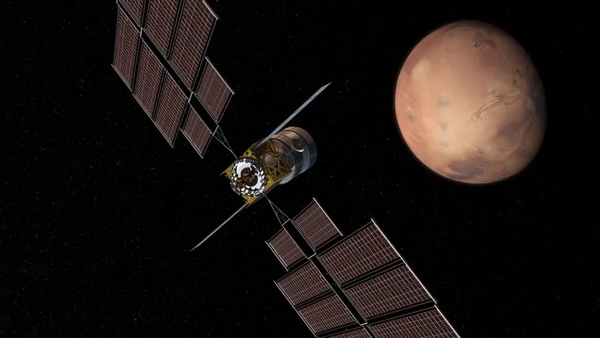Mars 2033: can we do this?by Jeff Foust
|
| “2033 is really ideal from an engineering and design point of view,” said Duggan. |
“It will give us a goal and a point to work towards. And if you have that, things start moving,” Perlmutter said at the Humans to Mars Summit conference in 2018, where attendees received their own bumper sticker (see “Martian deadlines”, The Space Review, May 21, 2018).
That year was not picked at random. The 2033 launch window happens to be particularly favorable in terms of energy required to make the transit from Earth to Mars. It was also, at the time it was being promoted, well in the future: plenty of time to make decisions on how to design the mission, secure funding, and develop the hardware needed to carry it out.
Time, though, is running short: 2033 is now just a decade away, and NASA, focused on returning humans to the Moon, has shown little public interest in a 2033 crewed Mars mission. Has the door closed on that launch window?
A few advocates are holding out hope, arguing that, at least technically, a 2033 or 2035 human mission to fly by or orbit—but not land on—Mars is still in the cards.
“2033 is really ideal from an engineering and design point of view,” said Matthew Duggan, manager for exploration at Boeing, during a panel at the 2023 edition of the Humans to Mars Summit last month in Washington. “Yes, I would be in a hurry to get there. That makes the mission the easiest it can be with the least risk to the mission overall.”
Hoppy Price, chief engineer for the robotic Mars exploration program at JPL, agreed. He argued that most of the capabilities needed for a flyby or orbital mission were already available except for a transit habitat. “Is nine years or ten years a big rush to develop and test the transit habitat? I don’t think so,” he said. “I think that’s enough time to pull that off.”
Both Duggan and Price offered concepts for such missions in their presentations at the panel. One by Price would enable a mission launching in 2033, sending a four-person crew to Mars. They would spend 30 days orbiting Mars before returning to Earth (via a flyby of Venus), for a total mission duration of 570 days.
| “Is this something that would be doable by 2033? I think so, but it’s big investment,” Price said. |
That concept would require a lot of launches: four of the Space Launch System and 13 of commercial vehicles in the class of Falcon Heavy. Most would carry propulsion stages using hypergolic propellants needed for sending the spacecraft to Mars, inserting it into Mars orbit, and sending it back to Earth. One of the SLS launches would ferry the crew to the transit habit on Orion, which would also bring the crew back to Earth vis direct entry at the end of the mission.
“Is this something that would be doable by 2033? I think so, but it’s big investment,” Price said. The launch number of launches “might be daunting,” he acknowledged.
A flyby mission would be considerably simpler. “That further reduces the mission complexity and the amount of elements that you have to have in play to get humans to Mars and get them safely back,” said Duggan. One flyby option, launching in 2035, would require three SLS launches, including one ferrying the crew on Orion, and two Falcon Heavy-class commercial launches.
 Former Rep. Ed Perlmutter (D-CO) showing off a bumper sticker promoting a 2033 Mars mission at a hearing several years ago. (credit: House Science Committee webcast) |
“An easy way to criticize a flyby is to say, ‘Well, that’s just a stunt. You don’t gain anything from it,’” he said. “That doesn’t look at it in the big picture, which is the flyby is just the first step towards a landing.”
However, just because a mission concept seems feasible or doable doesn’t mean it will be easy. Other panelists at the conference noted that trajectories and launch vehicles aren’t the only things that need to be considered for such a mission.
“I want to get to Mars, and I want to get there as soon as possible,” said Phil Hattis, a fellow at Draper. He was concerned about radiation exposure, both from solar storms and galactic cosmic radiation, as well as the engineering challenges of in-space assembly of all the elements needed for a Mars mission.
“Our biggest concern right now is the food. How are we going to be able to bring enough food for a year and a half or two and a half years, given our engineering status, and make sure that it’s stable and safe and provides the adequate nutrition?” said Jancy McPhee, associate chief scientist of NASA’s Human Research Program. “This is not just a two-week trip where you can eat chicken nuggets and everything’s going to be fine.”
There was no consensus from the discussion whether any of those challenges were insurmountable for a mission launching in a decade or so. McPhee, though, urged caution. “I think we want to get humans to Mars quickly, but we also want to get them back again,” she said. “I think it is worth it to pause a little bit and make sure we’ve done our diligence, to make sure we really think it’s going to be a successful mission.”
Price warned of competition for going to Mars. “I can think of one other country that I think could pull off a 2033 or 2035 flyby mission,” he said, an obvious reference to China, whose government has not publicly talked about a human Mars mission in that time frame.
SpaceX, of course, has also talked about sending humans to Mars—to land rather than orbit or flyby—on similar or earlier timescales, with the usual caveats about schedules. “I wish them the best of luck,” Price said. “It’s not beyond the realm of possibility that a private company could send humans to Mars before NASA or other international space agencies.”
NASA has not indicated any interest in a human Mars mission of any kind in that 2033 opportunity. NASA administrator Bill Nelson has stated several times that the agency could be ready to send humans to Mars around 2039.
Even that might be stretching it. During another panel at the Humans to Mars Summit, agency leaders were cautious when asked if a human Mars landing by 2040 was feasible. “We’re very supportive of doing it,” Nicola Fox, associate administrator for science, said. “I think that would be a bit ambitious.”
| “I think we want to get humans to Mars quickly, but we also want to get them back again,” McPhee said. “I think it is worth it to pause a little bit and make sure we’ve done our diligence, to make sure we really think it’s going to be a successful mission.” |
“That is going to be tough,” said Jim Free, associate administrator for exploration systems development. A landing at the end of the 2030s would require launches as early as 2032 to start prepositioning elements needed for the mission, he said. “It absolutely is aggressive to do that.”
“That is an audacious goal,” added Jim Reuter, associate administrator for space technology.
There is also no longer a congressional backer for an early human Mars mission. Ed Perlmutter retired from Congress at the end of last year, and no one on Capitol Hill has, so far, taken up the mantle or waved the bumper sticker calling for humans to Mars in 2033.
Advocates were undeterred. “I don’t want to make it sound like it’s easy,” Price said. “A 2033 orbit-only or flyby mission could be feasible, and there could be fallback options if the schedule couldn’t be met. But it would be a very bold mission to pull off.”
The panel’s moderator, Beth Mund, even suggested a new bumper sticker: “2035: totally doable.”
Note: we are using a new commenting system, which may require you to create a new account.
